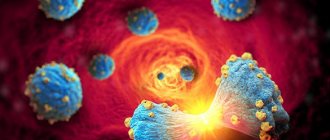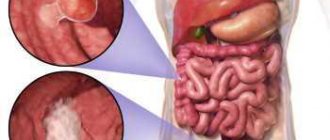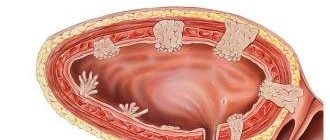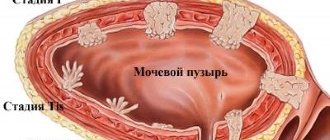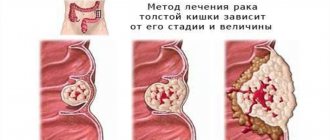Rectal cancer today is not a death sentence. The disease is highly treatable if the disease is detected in a timely manner. However, its main danger is the slow asymptomatic growth of the tumor, which often begins to appear 2-3 years after formation. The most effective treatment for this type of cancer is rectal resection. The procedure is described in detail on the website https://ru.bookimed.com/clinics/procedure=rezekcia-pramoj-kiski/.
We tell you in what cases surgery to remove rectal cancer is indicated and what alternative methods of treating the disease are in the arsenal of modern medicine.
Features of treatment of rectal oncology at different stages
There are four ways to treat colorectal cancer: surgery, radiotherapy courses, chemotherapy and targeted effects on the tumor. At the first stage, the tumor affects only the mucous/submucosal membranes and responds well to treatment with chemotherapy. At the second stage, the tumor begins to grow, but does not metastasize - in this case, surgeons resort to its resection.
In the third and fourth stages, oncological processes spread to the entire rectum, go beyond its limits, the tumor metastasizes to the liver, lungs, and bone tissue. If it cannot be removed by surgery to prolong the patient's life, treatment is aimed at reducing the symptoms of the disease.
Make an appointment
The Sofia Oncology Center is located in the Central Administrative District (CAO) in Moscow, next to several metro stations: Novoslobodskaya, Tverskaya, Chekhovskaya, Belorusskaya and Mayakovskaya.
You can make an appointment with an oncologist by calling +7 or using the online form.
Surgery to remove colorectal cancer
As a rule, it is used at stages 1-2 of the disease without metastases. During resection, the surgeon removes the affected tissue along with surrounding lymph nodes. Surgery is also used at stage 3, provided that the secondary tumors are located close, but in this case radiotherapy is performed before surgery.
Most procedures of this kind are performed using a minimally invasive endoscopic method using a proctoscope. The operation is performed through small punctures. This not only avoids large incisions, but also significantly reduces recovery time.
Depending on the size of the tumor, resection is carried out in one or two stages. If a patient needs to have the rectum and sphincter removed, the surgeon first removes the tumor tissue, then creates a colostomy - a section of the rectum is brought out. Often this is a temporary measure while the stitches heal. After complete recovery of the body, the stoma is closed. Treatment may be combined with chemotherapy or radiation therapy.
The process of radiation therapy
Preparing for treatment
During this period, additional studies are carried out to clarify the localization and assess the condition of healthy tissue surrounding the pathological focus.
Before starting a course of radiation, radiation doses are carefully calculated and its methods are determined, with the help of which it is possible to achieve maximum destruction of tumor cells and protection of healthy tissue in areas of the body subject to exposure.
Your doctor will decide what dose of radiation you need, how to administer it and how many sessions it will take.
A whole group of highly qualified specialists - physicists, dosimetrists, mathematicians - helps to carry out these complex calculations. It sometimes takes several days for a decision to be made. This procedure is called planning.
During the simulation (planning), you will be asked to lie quietly on the table until the doctor uses a special X-ray machine to determine the radiation field. There may be several such areas. The irradiation fields are indicated by dots or lines (marking), using special ink. This marking should remain on the skin until the end of treatment. Therefore, while taking a shower, try not to wash it off. If the lines and dots start to blur, tell your doctor. Don't draw the dots yourself.
Already in the pre-radiation period:
- do not use tinctures of iodine and other irritating agents on areas of the skin that will be exposed to radiation;
- should not sunbathe;
- If there are diaper rashes or rashes on the skin, you should point them out to your doctor. He will prescribe appropriate treatment (powders, ointments, aerosols);
- If radiation therapy will be carried out to treat a tumor of the maxillofacial area, preliminary sanitation of the oral cavity (treatment or removal of carious teeth) is necessary. This is the most important measure for the prevention of radiation complications in the oral cavity.
How does a treatment session work?
You will be asked to lie quietly on the table until the radiologist uses a special X-ray machine to determine the radiation field. There may be several such areas. The irradiation fields are designated by dots or lines (marking), using special ink for this.
This marking should remain on the skin until the end of treatment. Therefore, while taking a shower, try not to wash it off. If the lines and dots start to blur, tell your doctor. Don't draw the dots yourself.
Already in the pre-radiation period, you should not use iodine tinctures and other irritating agents on areas of the skin that will be exposed to radiation. You should not sunbathe. If there are diaper rashes or rashes on the skin, you should point them out to your doctor. He will prescribe appropriate treatment (powders, ointments, aerosols).
If radiation therapy is carried out to treat a tumor of the maxillofacial area, preliminary sanitation of the oral cavity (treatment or removal of carious teeth) is necessary. This is the most important measure for the prevention of radiation complications in the oral cavity.
Radiotherapy and chemotherapy
Ionizing radiation for the treatment of rectal cancer is used both as an independent method of therapy and before/after surgery. The goal of radiotherapy is to reduce the tumor in size, stop its growth or destroy the atypical tissue remaining in the body and reduce the risk of relapse.
The goals of chemotherapy are similar to radiation treatment. This type of therapy is also used to destroy single metastases. The drugs are usually administered through IVs.
Both radiotherapy and chemotherapy have a number of side effects: after the procedure, most patients experience nausea, vomiting, weakness, and fatigue. Partial hair loss is possible in the area exposed to radioactive rays. If all the doctor’s instructions are followed, the patient’s condition gradually returns to normal.
Advantages of Sofia Cancer Center
In the cancer center, patients do not feel like they are in a hospital - we have a stylish and modern interior design, comfortable rooms, and a restaurant on the roof with a panoramic view. We introduce advanced treatment technologies and save patients' lives while maintaining its quality. We have everything: in two buildings with a total area of 35,000 sq. m. There is not only an oncology center, but also departments of surgery, diagnostics, a pharmacy, a hospital, and dentistry.
Advantages of the Sofia Cancer Center:
- doctors with unique experience in treating cancer;
- excellent equipment of the center: we have one of the best equipment in Moscow;
- provision of medical services in full compliance with Russian and international standards (JCI);
- not only treatment, but also rehabilitation: having overcome cancer, the patient needs a full-fledged recovery program in order to minimize the risks of complications and relapses - our patients quickly return to their previous lives;
- increased comfort: individual support, cozy wards and offices, special care from the staff;
- psychological support for cancer patients;
- 30 years of unique experience;
- large parking for patients.
Treatment
What influences the choice of the type of treatment that is right for YOU?
- Stage of the tumor process.
- Height of tumor location.
- The presence or absence of other diseases. Be honest with your doctor. Some diseases are a contraindication for one or another type of treatment.
- The most effective type of treatment in your case is selected.
- Your age.
- The risk of complications from a particular type of treatment.
Determination of stage according to TNM classification
To stage the tumor process, the TNM system is used, where T characterizes the tumor itself, its size, the depth of invasion of the intestinal wall, N is the involvement of regional lymph nodes, M is the presence/absence of distant metastases.
The wall of the rectum consists of 4 layers. The innermost layer is the mucosa, separated from the muscularis submucosa; The outside of the rectum is covered with a serous membrane.
| Stage | TNM | Description |
| I | T1-2NoMo | The tumor grows into the submucosal (T1) or muscular (T2) lining of the rectum. There is no involvement of regional lymph nodes (N0), distant metastases (M0). |
| II | T3-4N0M0 | The tumor invades all layers of the rectum:
There is no involvement of regional lymph nodes (N0), distant metastases (M0). |
| III | T1-4N1-2M0 | There are metastatic foci in regional lymph nodes (N1-2), but no distant metastases (M0). |
| IV | T any N any M1 | There are distant metastatic foci (M1). |
3. Oral problems, hearing problems, nausea, diarrhea, sexual problems
Oral problems
Before starting radiation therapy to the head and neck, see your dentist for a thorough examination and treatment of dental and oral problems. Radiation can cause unpleasant symptoms:
- Mouth ulcers;
- Lack of saliva;
- Thickening of saliva;
- Difficulty swallowing.
It is important to tell your doctors about these side effects of radiation therapy. Most likely, they will help you cope with your problems. Among other things, to get rid of these symptoms you need to give up spicy and sour foods, as well as alcohol and tobacco. It is helpful to brush your teeth frequently with a soft brush and fluoride toothpaste.
Hearing problems
Radiation therapy can cause hearing loss. One possible cause is the thickening of the wax in the ears due to radiation. You should definitely report this problem to your doctor.
Nausea and radiation therapy
Radiation to the head and any part of the digestive tract may cause nausea and vomiting. Tell your doctor about this symptom because there are medications that can help treat the problem.
Diarrhea
Radiation therapy to the abdomen and stomach may cause diarrhea as a side effect. Diarrhea usually begins a few weeks after starting treatment. Most likely, in this case, the doctor will prescribe special medications and a special diet.
Sexual problems
Radiation therapy to the pelvis can affect fertility and sex drive. Pregnancy is contraindicated for patients undergoing radiation therapy, as the radiation can seriously harm the fetus. Radiation therapy to the pelvic area in women can stop menstrual periods and cause other menopausal symptoms.
In men, radiation to the testicular area can affect the number of sperm produced and the functionality of the sperm. This does not necessarily mean that you will not be able to have children. But in any case, the problem should be discussed with a doctor.
Radiation affecting the pelvic area can cause painful intercourse in some women. Radiation therapy can also cause scarring, affecting the vagina's ability to stretch. In men, radiation can affect the nerves and blood vessels responsible for erections.
About our clinic Chistye Prudy metro station Medintercom page!
Targeted therapy
Targeted therapy is a fundamentally new direction of pharmacotherapy, which involves the use of drugs that block various stages of carcinogenesis at the molecular level. An example of such a drug is cetuximab, which blocks EGFR, the epidermal growth factor receptor. EGFR is located on the surface of cells and helps them grow. Colorectal cancer cells contain large amounts of EGFR, so cetuximab interferes with the growth of tumor cells and causes their death.
Causes and risk factors
Typically, colorectal carcinoma is a consequence of malignant degeneration of intestinal polyps and, especially, serrated adenomas. Up to 20% of intestinal cancer develops against the background of hereditary pathology. Predisposing factors traditionally include chronic ulcerative colitis and granulomatous colitis, and the longer these diseases last, the higher the risk of developing cancer.
Insufficient consumption of plant fibers and an excess of animal proteins and fats increases the likelihood of colorectal cancer. Carcinogens enter the body as part of food products or are formed as a result of the interaction of various bacteria with food. The exact mechanisms of formation of carcinogens are not reliably known.
Clinical picture
Colorectal carcinomas grow slowly, so it takes a long time for the tumor to reach significant size and clinical symptoms to appear. The symptoms themselves are quite varied and largely depend on the location of the tumor and the degree of its invasiveness.
If cancer grows in the right side of the large intestine, which has a thin wall and a large lumen diameter, then it rarely causes a picture of intestinal obstruction. Hidden blood loss is often observed, manifested by increased fatigue and weakness. Often tumors do not bother the patient at all until they reach enormous sizes.
The lumen of the left sections of the large intestine is somewhat smaller, and the feces are denser. Taking into account the fact that carcinoma here in most cases covers the entire circumference of the intestine, this leads to the appearance of symptoms of partial or complete intestinal obstruction. Often the patient’s first complaints are colicky abdominal pain, alternating diarrhea and constipation, and blood may be present in the stool. Perforation of the intestinal wall with its contents entering the abdominal cavity is accompanied by a picture of limited or diffuse peritonitis.
When carcinoma develops in the rectum, its first manifestation is usually the discharge of blood from the anus during bowel movements. The patient may also be bothered by false painful urges to cleanse the intestines, a feeling of incomplete emptying, and pain in the rectum. Often, colorectal cancer is not accompanied by any pronounced local symptoms at all and makes itself known already with signs of metastatic disease: enlarged lymph nodes, liver and spleen, ascites.
Tomotherapy for colorectal cancer
Traditional external irradiation of a tumor cannot be a radical method of treating cancer, since we are not able to deliver the dose of radiation necessary to completely destroy it without damaging healthy tissues of the body. Under these conditions, the doctor always faces the difficult task of selecting the dose of radiation that will have the most effective effect on the tumor with minimal risk of radiation complications. The introduction of modern methods of radiological treatment becomes a turning point in the use of radiation therapy. The unique TomoTherapy HD system, which is used in our clinic, combines two innovative technologies:
- IMRT is intensity modulated radiation therapy that allows radiation to be distributed strictly according to the shape of the tumor, thereby avoiding damage to healthy tissue.
- IGRT is a technology that ensures precise positioning of the patient with three-dimensional visualization of the tumor before each radiation session.
The result of this approach is the ability to deliver a higher dose of radiation directly to the tumor, bypassing healthy tissue, which allows, in some cases, to reduce treatment time and achieve results similar to surgical ones.
